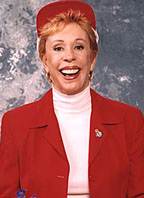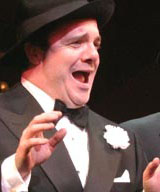May 2, 2005
FeatureThe Diva Principle:
How Television Uses Broadway Icons
Call it the Diva Principle.
Television has always been fascinated by Broadway. In the early days, musical theater was a regular part of the variety show. Ed Sullivan, the undisputed king of the format, brought the latest stage hits into the American living room on Sunday night. Ed wasn't alone: Lawrence Welk, Dinah Shore, and Johnny Carson all made the Broadway musical a recurring guest star.
Skip ahead to today, when the Tonys tank lower and lower each year, regardless of which celebrity host has been brought in to inject ratings into the award show ignored in droves. After a noble but futile attempt by Rosie O'Donnell, the original cast performance has all but disappeared from the talk show landscape.
Yet Broadway lives. Although the form has changed, the Broadway musical remains very much a part of television, kept alive by casting directors who rightly recognize that the hardest-working actors in showbiz are more than willing to turn in a guest shot on the hit of the week for a chance at national exposure.
Yet not just any old Broadway performer will do. You need a diva.
 Carol Burnett has the best hats |
Let's start at the very beginning (a very good place to start). When you read, you begin with A, B, C. When you watch, you begin with Carol and Bea.
Carol Burnett and Bea Arthur both got their start on the legitimate stage. Carol's first big break was in Once Upon a Mattress, a farcical retelling of The Princess and the Pea. From there, she would graduate into specials with Julie Andrews and eventually her own sketch comedy show, recasting herself as a modern-day Lucille Ball, an unflappable charmer with impeccable wit. Bea did Bertold Brecht and Sid Caesar before she hit it big with Fiddler on the Roof and Mame. When Bea did friend Norman Lear a favor and appeared on All in the Family as Edith Bunker's liberal cousin Maude Findlay, it was only a matter of time before she got her own show, creating one of the iconic characters of the 1970s and redefining the limits of what a sitcom could do.
There were other stage divas gone television: Angela Lansbury springs to mind. As the star of Mame, Sweeney Todd and Gypsy on stage, the versatile British actress had wowed theater audiences for years. But Lansbury was somewhat of a special case, a patrician beauty with an extensive film resume who ended up typecast for years as eccentric Jessica Fletcher in the long-running and hackneyed — albeit beloved — Murder, She Wrote.
It would be difficult to typecast Carol and Bea. Yes, Carol was a zany physical comic whose routines seemed a cross between Buster Keaton and Noel Coward. Yes, Bea was an acerbic cynic who played assertive, outspoken feminists. Yet both dipped back into stage and film, presenting themselves as versatile and bankable icons. Writers took note. Producers took note. Casting directors took note. Most importantly, audiences took note.
Triumvirate triumphant
Flash-forward to today. The pulse of Broadway beats beneath the subtext of
most hit shows (and, in all fairness, many flops as well). The faces of Broadway
can be summed up into three categories: Liza, Bebe and Donna.
 The Male Liza |
The Bebe: Named for Bebe Neuwirth, this category applies often to recurring and regular characters. The performer has some name recognition, perhaps for another memorable television role, although the actor frequently will be quoted as saying "my heart belongs to the stage." The role the character inhabits will require comedic timing and/or dramatic talent, but the function of the character itself within the narrative is interchangeable with any other actor of similar caliber. (On Cheers, for example, Donna McKechnie played Sam's wife and later, Bebe would play Frasier's. Glynis Johns played Diane's mother; Frances Sternhagen later would play Cliff's.) The male equivalent is Jerry Orbach.
The Donna: Named for Donna Murphy, this category most often applies to guest characters. Donna Murphy is an honored, talented performer with a huge list of credits on stage and television — yet audiences can't remember who she is. Versatile and able to bring gravitas and class to practically any role, the small cult of fans who remember her name will woefully sigh, "She's so underused." Ms. Murphy herself has played two different roles on Law & Order, appeared through most of the first season of Murder One, was on a crossover episode of Ally McBeal and The Practice, and appeared on a recent episode of CSI. Big shows all, but most audiences require prompting: "She's the one who played Doc Ock's wife in Spider-Man 2." "Oh." Other examples are Audra McDonald and Judy Kuhn. The male equivalent is Victor Garber.
Sometimes the categories blend together. Kristin Chenowith started as a Donna, but moved up to Bebe status when she started appearing on The West Wing. Chita Rivera is a Liza who takes Donna roles. Patti LuPone was a Bebe when she appeared on Life Goes On, but has crossed the Liza line since. Betty Buckley and Phylicia Rashad think they're Lizas, but they're really Bebes. Brent Spiner was a Donna before he did Star Trek: The Next Generation — now, he's mostly a Bebe, but to Trekkies, he's a Liza. Peter Gallagher was a Donna, but became a Bebe when he got The O.C. (Why is Victor Garber still a Donna, even though he's got a pretty big role on Alias? Ask 100 people at the mall what his name is and what else he's been in. People tend to remember Gallagher from American Beauty and Center Stage. Who remembers Garber was in the TV version of Annie?)
The Broadway veterans are ubiquitous. Turn the channel, you'll find someone with stage experience and White Way roots. Even Pamela Anderson's new sitcom, Stacked, features Marissa Jaret Winokur, the Tony winner for Hairspray. It seems likely that Winokur is a Donna in this role, playing second banana to a pair of melons. Should her character, Katrina, become more popular or the show become a big hit, it's possible she'll graduate into a Bebe.
But what does it all MEAN?!
TV producers are, as a rule, lazy. The goal always has been to achieve maximum
results for minimum cost. Using divas in bit parts fills two needs: vague
name recognition and scale pay. Using actors with stage training and background
can be a shortcut; it means they've been around a script before and will know
how to get their scenes done with a minimum of muss and fuss. Try saying that
about the heiress of the week.
The theater sneaks into shows other ways, as well — - nearly every episode title for Desperate Housewives, for example, is taken from a Stephen Sondheim song. The Simpsons often spoofs Broadway musicals. Nearly every domestic comedy featuring school-age children will include the obligatory class play episode.
The variety show doesn't exist anymore. Audiences have forgotten Broadway. But television hasn't. In the early days, producers turned to Broadway stars to inject cachet. Today, producers turn to Broadway icons to offer class.
In the end, of course, it's a winning situation all around. Audiences get to see actual actors; the shows get to appear as if they know what they're doing. The divas? Well, eight retakes is a lot easier than eight performances a week.
Email the author.
All written content © 2005 by the authors. For more information, contact homer@smrt-tv.com
